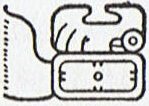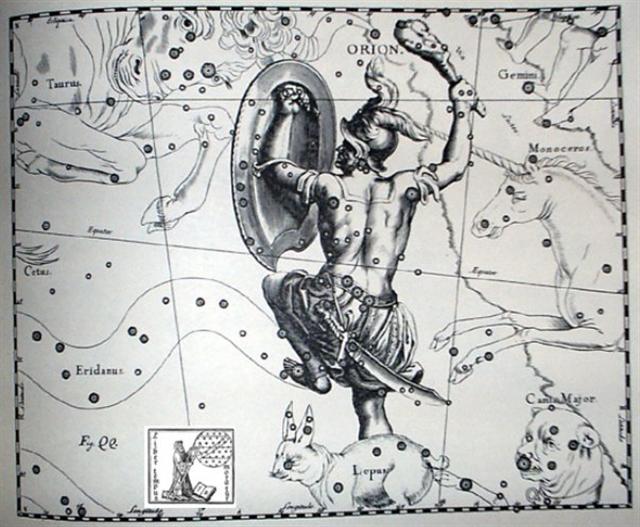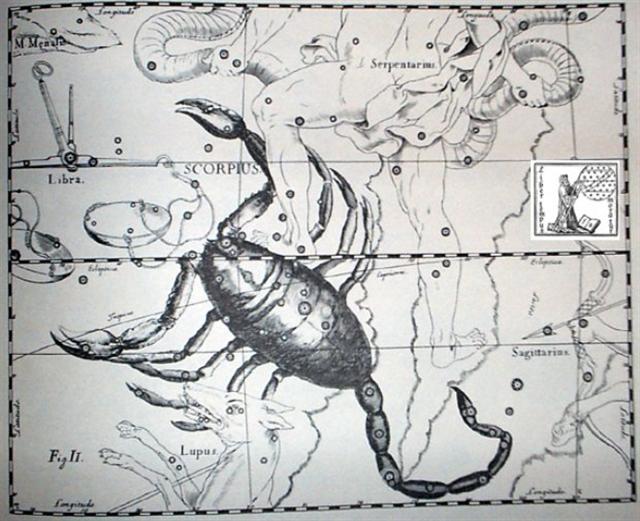The
September equinox
coincided with the
heliacal rising of the
bright (-0.94) Gienah (γ
Corvi), which determined the
13th Hindu station
Hasta (the Hand):
|
September 22 |
23 |
24 |
25 (268) |
 |
 |
 |
 |
|
Cb7-15 |
Cb7-16 (552) |
Cb7-17 |
Cb7-18 |
| te hokohuki |
e haga o rave hia |
te rau hei |
te hoko huki -
ma
te huaga |
|
Hasta-13 |
Zaniah
(185.9), Chang Sha (186.3) |
Intrometida
(187.4), Acrux (187.5) |
γ Com.
Berenicis (188.0), σ Centauri (188.1), Algorab (188.5) |
|
Pálida
(184.6), Megrez (184.9),
GIENAH
(185.1),
ε Muscae
(185.2) |
|
March 24 |
25 (450) |
26 |
27 |
|
θ Andromedae (2.7), ζ
Tucanae (3.5) |
π Tucanae (3.7) |
Ankaa, κ Phoenicis (5.0) |
λ Phoenicis (6.3), β Tucanae
(6.4) |
The
'fruits' hanging in front in Cb7-18 probably motivated
Metoro's ma te
huaga, which perhaps should be translated as with (ma)
the (te) place (-ga) of offspring (hua). He
may have been inspired by the Phoenix stars at RA 5.0:

Metoro's words e haga o rave hia could have
been an effort to express the idea of a
grasping ('biting', rave) hand in the west (Chikin)
located at the September equinox:

|
Rave
Ta.: Rave, to take. Sa.: lavea,
to be removed, of a disease. To.: lavea, to bite,
to take the hook, as a fish. Fu.: lave, to
comprehend, to seize. Niuē:
laveaki, to
convey. Rar.: rave,
to take, to receive. Mgv: rave,
to take, to take hold; raveika,
fisherman. Ma.: rawe,
to take up, to snatch. Ha.: lawe,
to take and carry in the hand. Mq.: ave,
an expression used when the fishing line is caught in
the stones. Churchill 2. |
LAWA, v. Haw., to work
out, even to the edge or boundary of
a land, i.e., leave none
uncultivated, to fill, suffice, be
enough.
Sam.,
lava, be enough, to complete;
adj., indeed, very. Tah., rava-i,
to suffice. N. Zeal., rava-kore,
lit. 'not full', poor. Fiji.,
rawa, accomplish, obtain,
possess.
Sanskr., labh, lambh,
to obtain, get, acquire, enjoy,
undergo, peform; lábha,
acquisition, gain; rabh, to
seize, to take. Lith., loba,
the work of each day, gain, labour;
lobis, goods, possessions;
pra-lobti, become rich;
api-lobe, after work, i.e.,
evening.
A.
Pictet refers the Lat. labor,
work, to this same family, as well
as the Irish lobhar and the
Welsh llafur. He also, with
Bopp and Benfey, refers the Goth.
arbaiths, labour, work, to the
Sanskr. rabh = arb, as
well as the Anc. Slav., rabu,
a servant. Russ., rabota,
labour. Gael., airbhe, gain,
profit, product.
This
Polynesian lawa is doubtless
akin to
LAWE, v. Haw., to carry,
bear, take from out of; lawe-lawe,
to wait upon, to attend on, serve,
to handle, to feel of; adj.
pertaining to work. Tah., rave,
to receive, to take, seize, lay hold
of; s. work, operation;
rave-rave, a servant, attendant.
Rarot., Paum., rave, id.
Sam., lave, to be of service;
lave-a, to be removed, of a
disease; lavea'i, to
extricate, to deliver. Fiji.,
lave, to raise, lift up. Malg.,
ma-lafa, to take, seize;
rava, pillage, destruction.
Sunda., rampok, theft. Mal.,
rampas, me-rabut, take
forcibly. Motu (N. Guinea),
law-haia, to take away.
Sanskr., labh, rabh,
see previous word, 'Lawa'.
Greek, λαμβανω,
έλαβον,
take hold of, seize, receive,
obtain; λημμα,
income, gain; λαβη,
λαβις,
grip, handle.
Lat., labor,
work, activity; perhaps also
Laverna,
the goddess of gain or profit, the
protectress of thieves;
rapio,
rapax.
Goth.,
raupjan,
to reap, pluck;
raubon,
to reave, rob. Sax.,
reafian,
take violently. Pers.,
raftan,
to sweep, clean up;
robodan,
to rob. Lith.,
ruba,
pillage;
rûbina,
thief. (Fornander)
|
... The
manik, with the tzab, or serpent's rattles as
prefix, runs across Madrid tz. 22 , the figures in the
pictures all holding the rattle; it runs across the hunting
scenes of Madrid tz. 61, 62, and finally appears in all four
clauses of tz. 175, the so-called 'baptism' tzolkin.
It seems
impossible, with all this, to avoid assigning the value of
grasping or receiving. But in the final confirmation, we
have the direct evidence of the signs for East and West. For
the East we have the glyph Ahau-Kin, the Lord Sun,
the Lord of Day; for the West we have Manik-Kin,
exactly corresponding to the term Chikin, the biting
or eating of the Sun, seizing it in the mouth
...
The unlucky number 13 is represented not
only in the ordinal number for the Hasta station but
also in my example of the Mayan Chikin glyph, where
we can count to 13 notches at left.
Megrez is
δ Majoris, at
the last corner of the quadrangle:

The distance from the March equinox to the
September equinox is not the same as that from the September
equinox to the March equinox, because summer is longer north
of the equator:
|
185 |
March 21 (80) |
northern summer |
|
September 22 (265) |
180 |
|
southern summer |
March 21 (445) |
Although the exact dates vary from year
to year the above is what I have perceived was the
idealized Gregorian structure. 185 = 5 * 37 and 180 = 5
* 36.
Metoro could have suggested this is the
final station of the northern summer Sun, in his comment
e haga o rave hia - this (e) as the bay (haga)
of (o) 'biting' (rave) counts (hia).
Counting (hia) from the beginning
of side b the glyph is number 552 -
392 = 160 (= 2 * 80). Gregorian day 160 is June 9, where
the first rau hei in the text arrives in front:
|
June
6 (157) |
7 |
8 |
 |
 |
 |
|
Ca4-1 (77) |
Ca4-2 |
Ca4-3 |
|
kua tupu te rakau |
kua tupu - te kihikihi |
te hau tea |
|
λ
Eridani (76.7) |
μ
Leporis (77.6), ĸ Leporis (78.0), Rigel (78.1),
Capella (78.4) |
ο
Columbae (78.8) |
|
December 4 (338) |
5 |
6 |
|
no stars listed |
Sabik (259.7), η
Scorpii (259.9), Nodus I (260.0) |
|
June 9 (160) |
10 |
11 |
12 (528) |
 |
 |
 |
 |
|
Ca4-4 (80) |
Ca4-5 |
Ca4-6 |
Ca4-7 |
| tagata
- te rau hei |
te
hokohuki i te moko |
te rau
hei |
e
gagata hakaariki |
|
λ Leporis (79.6) |
A9 |
Nihal (81.7), Mintaka (82.4) |
Al Hak'ah-3 / Mrigashīrsha-5 / Turtle-20
|
|
Bellatrix, Saif al Jabbar (80.7),
ELNATH (80.9) |
ε Columbae (82.6), Arneb (83.0), φ¹ Orionis
(83.1),
HEKA (83.2) |
|
December 7 |
8 |
9 |
10 (344) |
|
π Herculis
(260.7), Ras Algethi (260.8), Sarin (261.0),
ο Ophiuchi (261.4) |
ξ, θ Ophiuchi, ν
Serpentis, ζ, ι Apodis (262.2) |
ι Arae (262.8),
ρ Herculis (262.9), β, γ Arae (263.3), κ
Arae (263.5) |
σ Ophiuchi
(263.6) |
|
June 13 |
14 |
15 |
16 |
17 (168) |
 |
 |
 |
 |
 |
|
Ca4-8 |
Ca4-9 |
Ca4-10 |
Ca4-11 |
Ca4-12 |
|
manu |
te rau hei |
te hokohuki |
te moko |
te hokohuki |
|
Hatysa (83.5), φ²
Orionis
(83.6), Alnilam (83.7), Heavenly Gate, ν
Columbae (84.0) |
Three Stars-21 |
γ Leporis (85.9), μ Columbae (86.1), Saiph
(86.5) |
ζ Leporis (86.6) |
Ardra-6 / T8 |
|
Alnitak, Phakt (84.7) |
Wezn (87.6), δ Leporis (87.7), Tze (87.9),
BETELGEUZE (88.3),
ξ Columbae (88.5) |
|
December 11 |
12 |
13 |
14 |
15 (349) |
|
Al Shaula-17 /
Mula-19 |
Kuma (265.6),
σ Arae
(265.9), Ras Alhague (266.1), Sargas (266.3),
μ Ophiuchi, π Arae (266.5) |
Nan Hae
(266.6), ι Herculis (266.9), λ Arae (267.1)
|
Girtab, ο
Serpentis (267.6), Kelb Alrai, μ Arae
(268.1) |
Kew
Ho (268.6), η Pavonis
(268.7), Apollyon (268.9), Muliphen (269.0),
Basanismus (269.5) |
|
Lesath, δ Arae
(264.7), Choo (264.9), Alwaid, Maasym
(265.1), SHAULA
(265.3) |
Rau hei and moko in the weeks
before the northern midsummer could be connected with
Heka and its ominous influence.

In the nights of June the
tail of the Scorpion with its Sting could be observed
close to the Full Moon, reflecting the predicament of
the Sun.

A new King had to be inaugurated (hakaariki)
because the solstice would be lethal.
"Amongst authors in Antiquity, the tiny
Limia River between Northern Portugal and Galicia
(Spain) was said to have the same properties of memory
loss as the legendary Lethe River, being mistaken by it.
In 138 BC, the Roman general Decimus Junius Brutus
sought to dispose of the myth, as it impeded his
military campaigns in the area. He was said to have
crossed the Limia and then called his soldiers on the
other side, one by one, by name. The soldiers,
astonished that their general remembered their names,
crossed the river as well without fear. This act proved
that the Limia was not as dangerous as the local myths
described." (Wikipedia)
There are 3 days from day 160 (June 9) to June 12 (day
528 = 2 * 264 = 392 + 136), and 528 - 160 = 368 (January
3).
And if we should count (hia) 3
days ahead from e haga o rave hia we must look at
Cb7-19. See next page.
|











